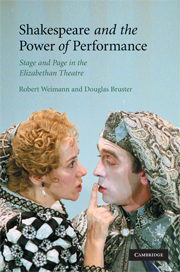Book contents
- Frontmatter
- Contents
- Acknowledgments
- Introduction
- Chapter 1 “Moralize two meanings” in one play: contrariety on the Tudor stage
- Chapter 2 Performance, game, and representation in Richard III
- Chapter 3 Mingling vice and “worthiness” in King John
- Chapter 4 Clowning: agencies between voice and pen
- Chapter 5 Clowning at the frontiers of representation
- Chapter 6 Cross-dressing and performance in disguise
- Chapter 7 Personation and playing: “secretly open” role-playing
- Chapter 8 Character/actor: the deep matrix
- Chapter 9 Character: depth, dialogue, page
- Chapter 10 King Lear: representations on stage and page
- Notes
- Index
- References
Chapter 5 - Clowning at the frontiers of representation
Published online by Cambridge University Press: 22 September 2009
- Frontmatter
- Contents
- Acknowledgments
- Introduction
- Chapter 1 “Moralize two meanings” in one play: contrariety on the Tudor stage
- Chapter 2 Performance, game, and representation in Richard III
- Chapter 3 Mingling vice and “worthiness” in King John
- Chapter 4 Clowning: agencies between voice and pen
- Chapter 5 Clowning at the frontiers of representation
- Chapter 6 Cross-dressing and performance in disguise
- Chapter 7 Personation and playing: “secretly open” role-playing
- Chapter 8 Character/actor: the deep matrix
- Chapter 9 Character: depth, dialogue, page
- Chapter 10 King Lear: representations on stage and page
- Notes
- Index
- References
Summary
In the preceding chapter we explored how the conjuncture of bodily performance and literary language helped constitute the agencies of clowns and fools. We now move from the study of doubly encoded agencies to the comically delivered forms and functions of clownish performance in both presentation and representation. For the preeminence of a presentational purpose, we will turn to what arguably is the most articulate jester in the Elizabethan period, the non-Shakespearean player/clown in Thomas Nashe's Summers Last Will and Testament (1592). Along with the more (re)presentational Launce in The Two Gentlemen of Verona, we shall then glance at the shape and purpose of several role-playing clowns in Shakespeare's plays after the watershed year of 1594.
The entirely pragmatic distinction made here between clowns and fools bypasses their complex genealogy. Reaching back to late ritual practices such as the men's ceremonial, “fool” actually antedates modern theatrical forms of clowning. As far as their etymology provides a clue, the word “clown” is, according to the OED, “of later introduction” and retains a rural connotation, such as a “mere rustic, a boor,” or “a clout,” with only a late sixteenth-century theatrical adaptation. In contrast, “fool” derives from Old French via Middle English sources. In Shakespeare's theatre the transition from clowning to fooling is not as clear-cut as the departure of clownish Will Kemp and the subsequent playing and singing of Robert Armin have led some critics to assume.
- Type
- Chapter
- Information
- Shakespeare and the Power of PerformanceStage and Page in the Elizabethan Theatre, pp. 99 - 116Publisher: Cambridge University PressPrint publication year: 2008

